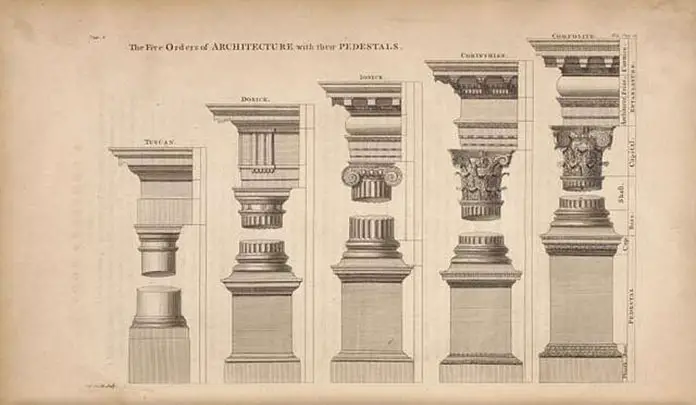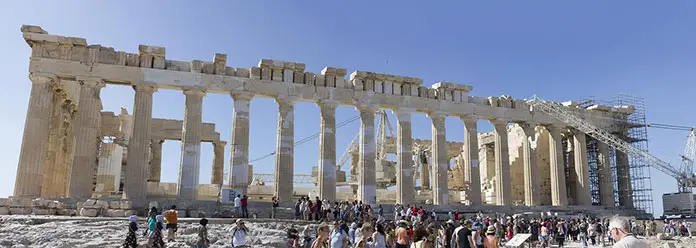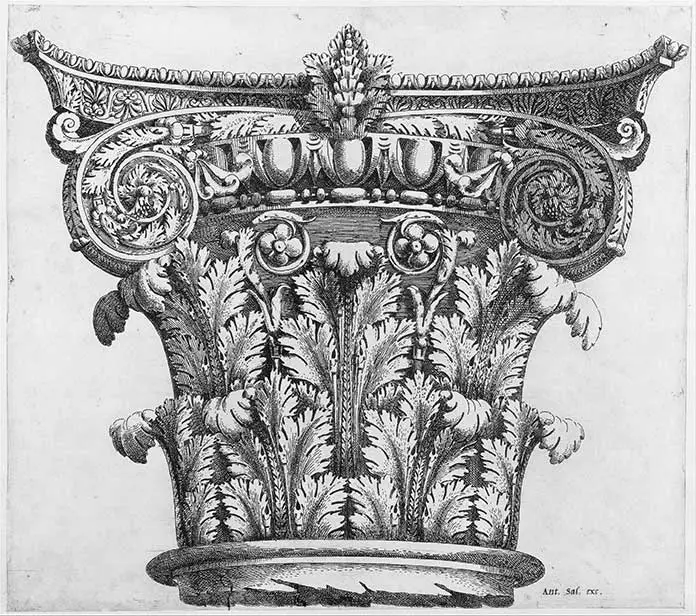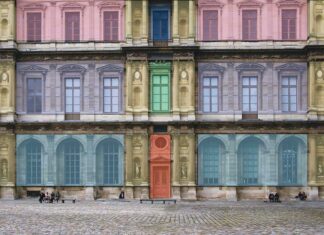An architectural order is a building system depending on rules and specialized techniques that are used in classical architecture to create columns and entablatures, which are the important parts of structures. Greeks and Romans, two great publics who formed the foundations of Western civilization, developed classical architectural orders.
These orders are standardized guides for creating both aesthetically and functionally “correct buildings”. Every architect in the classical period designed structures based on these vocabulary-like rules.
In this article, we will explore the significance of classical orders, how to identify them, describe and analyze each one, as well as learn characteristic features and famous examples of them.
We’ll also examine how are these architectural orders used in contemporary architecture and what are modern examples of architectural orders. Let’s dive into the article.
What are Classical Architectural Orders?
Besides three Greek architectural orders, Romans developed two types of classical orders in architecture. These are respectively:
- Doric Order
- Ionic Order
- Corinthian Order
- Tuscan Order
- Composite Order
The first three classical orders of columns in the Western world, the Doric, Ionian and Corinthian orders, originated in ancient Greece. Later, the Romans invented the Tuscan order, which is simpler than Doric, and the Composite order, which is more ornate than Corinthian.
These classical architecture orders were designed as an outcome of a rational civilization with the principles of proportions and magnificent composition.
Greeks used these special architectural rules mostly in designing temples. That’s why classical styles are also commonly known as temple orders. However, it is possible to see these 5 orders of architecture in many public structures and individual buildings belonging to the nobles as well.
Although these buildings have similar architectural elements, there are major differences in details and these details make each structure unique.
So, let’s continue with how to identify architectural orders.
How to Identify Classical Orders?
Classical architecture has been developed step by step with the accumulation of architectural knowledge and experience over centuries.
In addition, three basic architectural principles, utilitas (utility), firmitas (strength) and venustas (beauty) served an important role in the evolution of classical orders, Vitruvius said.
Column-beam static, which is a structural technique still used in today’s architecture, has formed the basic structural understanding of these five classical orders.
Columns, with ornate capitals, pediments, friezes and architraves, are the essential elements of orders. The easiest way to understand the type of architectural order in which these structures were built is to look at their columns.

Columns, the most distinctive elements of classical buildings, have unique capital designs. These column capitals are categorized according to the ornaments and decorations on them.
They provide differentiation of column orders. Thus, it becomes possible to distinguish the 5 classical orders of architecture by looking at their column capitals.
Three Greek Architectural Orders
The Greeks were a society that gave great importance to aesthetics. They’ve made various trials to make their buildings look beautiful from the outside.
As a result of these experiences, they managed to create some technical and proportional rules. Therefore, a rational understanding of beauty has emerged.
Architecture in Ancient Greece did not aim to produce original-looking buildings or very different designs. On the contrary, the crucial thing was to apply the architecture, which already had been specified as certain rules, in the most correct way.
Greek architects preserved architectural traditions and rules for centuries and transferred them to the next generations with very small changes. By this means, the architectural landscape of Ancient Greek was dominated by a common language.
There are three types of Greek architectural orders.
- Doric order
- Ionic order
- Corinthian order
These orders were invented by ancient Greek architects and later adopted by Romans as well. They have been used to adorn architectural structures for thousands of years. Each order has unique characteristics that distinguish it from others. Let’s start with Doric order.
1. Doric Order

Doric order, the simplest and oldest Greek order, basically consists of a crepis (3 exterior steps of Greek buildings), a sturdy column with no base, a simple capital, an entablature and a triangular pediment.
Doric columns have entasis. This means that the middle part of the column body is wider than the upper part and it narrows upwards.
There are two parts named abacus and echinus in the column capital. While the echinus has a cushion-like structure, an abacus is a square slab.
Above the columns, there is a frieze consisting of metopes and triglyphs. Triglyphs are a kind of relief, while metopes are the spaces between these reliefs. These reliefs depict some epic wars and old stories.
The architrave, which is the first part of the triangle entablature, is quite plain in the Doric order of Greek architecture.
Briefly:
- The Doric order is the only order without a column base.
- Short and plump appearance resulting in a rough and bulky stance
- Doric columns have thin shaft channels called grooves that surround the body.
- The lack of intricate designs makes it cost-effective.
- Its solid structure makes it durable against heavy loads.
2. Ionic Order

Ionic order is more ornate than Doric. It features columns with a base, a capital with volutes, an entablature, a crepis and a pediment.
The Ionic columns, which are thinner and more elegant than the Doric columns, are believed to reflect the beauty of a woman.
The most important sign of the Ionic order is the volutes, which look like ram horns on the column capitals. Even from these elements alone, it is possible to distinguish an Ionic building.
Developed after Doric, the Ionic order was often used in Ancient Greek architecture and adorned temples, porticos and public buildings.
Briefly:
- Columns are situated on column bases, meaning more durability.
- Column capitals have characteristic ornaments as volutes.
- Ionic columns do not have entasis.
- The height of a column base is = 1/2 of the diameter of the column.
- A column base consists of circular-shaped moldings called torus and scotia.
- More ornate and elegant design making it more popular, but more expensive
3. Corinthian Order

Corinthian order was frequently used in the Hellenistic age, one of the late Greek periods that developed an aesthetic sense of beauty. The order takes its name from the city where the order was first seen.
As far as is known, the roots of the Corinthian columns in Ancient Greece date back to the 3rd century BC.
Although the Corinthian order carries most of the characteristics of the Ionic order, the most important difference is seen in the column capital.
Carrying the elegance of the Ionic order one step further, Corinth features acanthus leaves with volutes on column capitals. These leaves nicely surround the column capital in a more natural form and increase the level of its details.
Thus, it has the most intricate design among the three Greek orders of architecture. It has been used in ancient Greece and Rome and is still used in various architectural styles.
Briefly:
- Most ornate one among Greek classical orders
- Has acanthus leaves in addition to volutes in capitals
- Includes all architectural elements of the Ionic order
- Most expensive of the three orders
Differences Between Doric Ionic & Corinthian Orders
These three types of Greek orders have unique characteristic features, pros and cons that distinguish each one from the others.
For example, the Doric order, unlike the other two Greek architectural orders, doesn’t have a pillar base. The Doric columns sit directly on the stylobate.
While Corinthian and Ionic columns have slender and long bodies, Doric pillars feature a rough and bulky appearance, with no ornate.
Corinthian columns have the longest capitals as they contain 2 rows of acanthus leaves, volutes and various floral motifs. This makes the columns appear even longer.
Doric columns have entasis to reduce the impacts of the bulky stance and make the body look taller.
Architectural Orders in Roman Architecture
The Ancient architecture of Rome has managed to carry the rich architectural knowledge inherited from classical Greek architecture much further. It not only added 2 important orders but also diversified the usage areas of these classic styles.
The Romans, who spread over much wider lands, were very advanced in engineering. They have also moved away from the prescriptivism of Ancient Greek architectural orders.
Ancient Roman architecture brought innovations such as using more than one order together in buildings, developing various architectural structural elements, or differentiating the architectural form with new functions.
In this direction, you should definitely read our article about Ancient Roman architecture to enhance your knowledge about Rome’s building techniques and famous examples.
The two Roman architectural orders that developed in addition to the classical Greek styles are the Tuscan and Composite orders.
4. Tuscan Order

The Tuscan order is a simplified version of the Doric order, with ungrooved bodies. There are no triglyphs or reliefs adorn the frieze. Thus, Roman Tuscan columns give the impression of an idealized simple structure.
It has a column base, echinus and abacus, a simple entablature. Just like the Doric columns, they have the feature of entasis. Moreover, the height of the pillar base is half of the width of the Tuscan column.
5. Composite Order

The Composite order architecture had developed as a mixture of the 2 Greek temple orders, the Ionic and Corinthian styles. Therefore, when we look at the column capitals and other ornaments, we can see that it has the most ornate and complex motifs among the five orders of classical architecture.
Composite column capitals are similar to Corinthian capitals since volutes and acanthus leaves are used together. However, composite capitals have generally two rows of acanthus leaves and so detailed ornates.
There is no major differentiation from the Ionic order that is observed in the other architectural elements above the pillars. It has been used in buildings that required elegance and grandeur.
Conclusion
In conclusion, Greeks and Romans developed rational rules for the most accurate design of an architectural structure. With the formation of these rules as a holistic design method, the term architectural order has emerged.
The classical orders have played a significant role in architectural history. Their influence can still be seen in contemporary architecture. While these 5 orders of architecture were originally developed in ancient Greece and Rome, they have continued to evolve and adapt over time.
The most basic classical architectural orders are the Doric, Ionic and Corinthian orders, developed by the Greeks, the Tuscan and Composite orders, developed by the Romans later on.
Thanks for reading. We’d love to hear your thoughts on the classical orders. Leave a comment below to share your opinions and join the conversation!
Frequently Asked Questions
A: The three Greek architectural orders are Doric, Ionic and Corinthian orders.
A: Tuscan and Composite orders are two Ancient Roman orders.
A: The purpose of architectural orders is to create a standardized vocabulary of design elements that can be used to create balanced architectural examples.
By using these standardized rules ancient architects were achieving proportion in architecture in a way pleasing to the eye both aesthetically and functionally.
A: While the identification of the five orders of architecture is credited to the Roman architect Vitruvius, these orders were invented centuries before him.
However, his book “De Architecture” (Ten Books on Architecture), written in the 1st century BC, includes all details and principles of classical architecture. It is the oldest architectural written source that has reached the present day.





















I have an old book/manuscript written by Giacomo Baratsii written in the 15th century . he was the author of this one I have. wondering if it has any value
Hi Lucy, thanks for your attention. If this book was really written by the famous Mannerist architect Giacomo Barozzi in the 15th century and is well preserved as the original edition, it may be worth between $500-$20000 depending on many criteria. Since this book is older than 100 years old, it will be considered to be an antique piece, and this will increase its value.
When we research on Google, found out 15th-century Barozzi book “Regles des cinq ordres d’architecture” is sold for $1000. However, the book you have may be worth more than this. You should consult old-book dealers or apply for auctions to determine the book’s value. It will also be a good idea to ask architecture historians from a reputable architecture school.
Important criteria to consider when determining the value of a book:
1) Condition
2) Age
3) Demand
4) Scarcity
5) Edition details
Hope you find its real value and deal your priceless book in the right hands. Have a nice day!